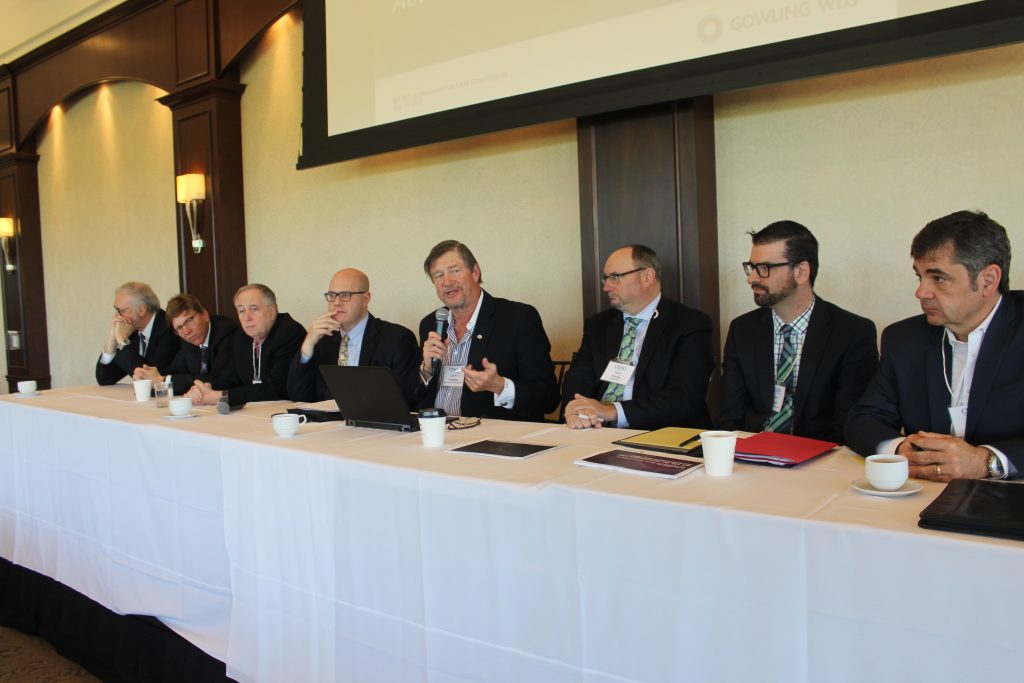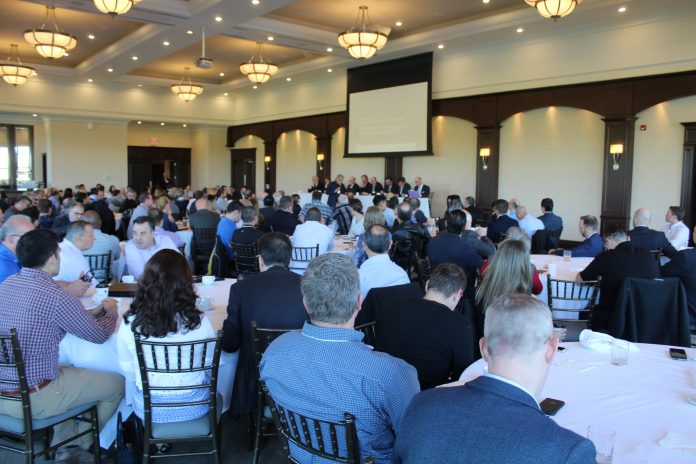When Ontario’s new Construction Act goes into effect July 1, there will be major changes in the way owners, contractors and design professionals fulfill their legal obligations and protect their interests. However, the biggest changes are another 18 months away, when significant prompt payment and new adjudication rules go into effect.
Several lawyers and consultants outlined the changes – including challenging transitional provisions – at a May 14 seminar sponsored by the Construction and Design Alliance of Ontario (CDAO).
Geza Banfai with McMillan LLP outlined the reasons for the new rules, which trace their roots to lobbying several years ago from the National Trade Contractors Coalition of Canada (NTCCC), which led to a private member’s bill that failed to move forward after government ministries and agencies, private owners, general contractors, consultants and lenders raised strong objections.
However, the provincial government agreed to commission lawyers Bruce Reynolds and Sharon Vogel to conduct an extensive review of old Construction Lien Act, dating back from the 1980s. After extensive consultation with stakeholders, Reynolds and Vogel submitted 101 recommendations, which became the foundation for the new Construction Act, which was passed and proclaimed just before Christmas last year.
By late April, government officials had drafted the necessary enabling regulations.
The changes in Bill 142 include several fundamental changes in lien periods, holdbacks, trust obligations, claims and procedures, said Ted Betts, the Head of Gowlings WLG’s Infrastructure and Construction Sector Group.
“A lot of these (legislative) changes are in the ‘modernization’ bucket,” he said. “It’s worthwhile for everyone to read through all of them.”
The so-called “modernization” changes include:
-
An extension of the lien “preservation period”, from 45 to 60 days and a
-
longer lien “perfection period” from 45 to 90 days after the last day the lien could have been preserved; both of these are to ensure there “is more time to negotiate and work out disputes rather than come to the lawyers;” and
-
Mandatory holdback release by the end of the holdback period, unless owners publish their intentions not to release the holdback in a public notice no later than 40 days after the publication of the Certificate of Substantial Performance.
“There’s a large deliberate gap,” Betts said. “An owner has to put their cards on the table” so that contractors and subtrades know where they are ahead of the lien filing deadline. Effectively, the new rules give the contractors and owners “an extra 20 days to settle disputes and avoid standoffs.”
The new legislation also allows for owners and contractors to release holdback on larger projects ($10 million or more) before the project is completed.
“The theme throughout all of the changes, in these subtle changes, is getting cash flowing through the project faster from the owners through the contractors to suppliers and subcontractors, and avoiding disputes.
There are other changes, as well:
-
Multiple improvements can be treated as separate contracts for the purposes of determining the substantial performance date and lien periods; so contractors don’t have to wait for every bundled part of the overall project to be completed before receiving their holdbacks. However, this provision applies at the owner/general contractor level, and Betts said “It’s not clear how this will play out on subcontractors and suppliers.”
-
New trust accounting rules require a separate trust account for contractors and subcontractors (though several projects can be funded through the same trust account). “Trust funds must be segregated and traceable in a contractor’s or subcontractor’s trust account,” as much as possible. This provision will help prevent creditors from grabbing trust funds (including holdbacks) when a contractor or subcontractor goes bankrupt as the trustee can now (hopefully) see clearly the trust account status.
-
There are several new forms, and new tools for contractors to request information about their projects.
One issue with the new legislation, said Bird Construction board member Paul Raboud, is the “tricky transition periods.”
The regulations and legislation suggest that if any contract is in force or “if there is any activity such as a pre-qualification happening before July 1,” the old rules apply.
Someone in the audience asked what the status would be if you were on a general pre-qualification list rather than for a specific project. Panelists responded by saying they aren’t sure – this may be one issue that would need to be resolved through a judicial process, but Raboud had a simple answer: “Assume (the lien period) is 45 days and not 60 days” — in other words, behave as if the old law applies, unless you are certain the new rules will be valid.
WeirFoulds LLP partner Glenn Ackerley said the “substantial performance” criteria has changed – monetary limits have been doubled. Now, substantial performance occurs when the value of the project outstanding meets the test of three percent of the first $1 million of the project’s value (instead of $500,000) 2 per cent of the second $1 million (again, instead of $500,000) and one per cent of the remaining value.
Jerry Paglia, director of procurement for the Regional Municipality of York, says there is a “lot of training needed for owners and consultants.”
“The phasing in of requirements (including the future prompt payment and adjudication provisions) is going to create complexity,” he said. “With two phase in periods, there could be three different forms of contract at the same time.”
“Owners, staff and consultants are going to have to know which contract applies to the project, with longer period for lien rights and less flexibility in what we can deduct from the payments.”
“We can’t deduct funds from other projects. The administration for the contracts will take longer.”
“There’s going to be more scrutiny on dealing with general contractors, terminating and not paying – we’ll have to publish it. (There’ll be) more of a public relationship, as that information trickles down to subcontractors.”
Eric Hoffstein of Minden Gross LLP said there will be new bookkeeping challenges, especially for smaller businesses, because of the much more stringent trust account requirements. “If you don’t have an outside bookkeeper helping with the accounting, now might be a good time to do that.”
Meanwhile, Steve Ness, president of the Surety Association of Canada (SAC), outlined new bonding rules, including the significant requirement that all public projects greater than $500,000 must have 50 per cent performance and payment bonds. “Public” includes the broader public sector such as school districts.
Other changes are intended to bring much greater clarity and responsiveness to the bond claims process, with finite deadlines for responding to claims by either accepting, denying or seeking more information.
The speakers indicated that, while the regulations going into effect on July 1 will impact the industry, the really big changes will occur in October, 2019, when the new law’s remaining provisions will be implemented.
These include mandatory prompt payment requirements. In about a year and a half, “owners must pay within 28 days of receipt of proper invoices,” said Chris Stanek, a partner at Gowling WLG. There are specific requirements in defining a “proper invoice”.
Owners can dispute the invoice “but must provide written notice in the prescribed form” within 14 days of receiving the invoice. The notice/response system is designed to tie in with a new adjudication system, which allows an exceptionally rapid decision on payments by a third-party expert adjudicator (agreed to by the parties or selected from a qualified panel) to determine if the payment would actually be due.
“If the owner has not paid but delivered a notice of non-payment, the contractor must give notice of dispute within seven days after receipt of the owner’s notice of non-payment,” Stanek said.
Betts added that there is an additional concern for contractors. “If a notice of non-payment has also not been delivered, the contractor will have 35 days to decide to either pay its subcontractor out of its own pocket, or to commence a fight with the owner through adjudication.”

Everyone in the construction supply chain will subject the notice/prompt payment provisions and if you don’t pay, “you will need to pay statutory interest.” If payments aren’t made after an adjudicator renders a determination, contractors and suppliers can leave the job site and charge remobilization fees if they return.
Banfai said the prompt payment and adjudication provisions, when they are implemented, are “collectively nothing short of a serious cultural change in the industry.”
One audience member asked what the rules will be for federal contracts. Betts responded that Reynolds and Vogel are currently conducting a review for the federal government, which is expected – along with several other provinces – to pass similar prompt payment legislation soon. These changes will bring Ontario and Canada to the state of practice in Britain, Europe, Australia, and most US states.
The new rules are a “significant change in the way we will doing things going forward,” Banfai said. “I think it is all for the better.”

